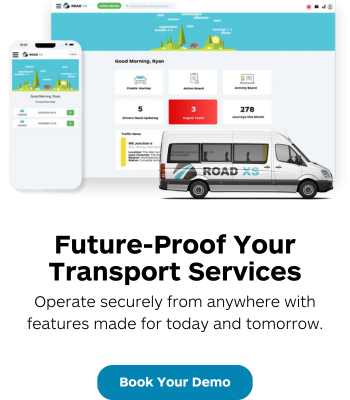In today’s fast-paced world, convenience and speed are prized commodities, especially in terms of transportation. The advent of allowing passengers to book rides on demand has transformed how we navigate cities, offering an effective alternative to traditional taxi services and public transit.
Allowing the booking of journeys on demand encapsulates a broad spectrum of on-demand transportation solutions, including micro-transit, which bridges the gap between private and public commuting options.
These services harness technology to allow users to easily book rides at their convenience, often utilising real-time data to enhance the user experience.
This article will delve into the various facets of rides on demand, exploring their benefits, challenges, and the future landscape of transportation while providing insights on how they compare to conventional services.
Overview of On-Demand Transportation
On-demand transportation is revolutionizing the way we think about public transit. Services provide flexible microtransit solutions that fill transit gaps with individual transportation options via a Demand mobile app.
With the advancement of smartphone technology, services have taken on-demand travel to the next level, offering corner-to-corner service without the constraints of a regular bus service schedule.
Rides on Demand presents customizable options such as multi-rider bookings and additional space for mobility devices. It also ensures all riders, including those in rural communities, can have ride confirmation days in advance or just before their trip.
Integrating existing public transport systems is essential for demand-responsive service to thrive, ensuring seamless transitions from the microtransit service to traditional route transit networks, such as reaching train stations or grocery stores.
Whether through the Demand app or an affordable app-based public transit service, on-demand rides are redefining accessibility while maintaining service hours within service boundaries.
Microtransit Solutions
The surge in Rides on Demand apps has ushered in a new era for public transport—a flexible micro-transit service that complements existing demand-response platforms.
This seamless integration allows transit agencies to respond nimbly to shifting ridership demands while significantly improving the user experience.
Riders can effortlessly self-register on these apps and quickly book a ride through an intuitive search capability or via an interactive map, thus enhancing accessibility to this innovative form of transportation.
Microtransit solutions, such as those offered by Rides on Demand, are particularly effective in servicing areas or routes with lower densities and historically minimal ridership.
They provide a cost-effective alternative to traditional fixed-route services and amplify the reach of public transport. Transit agencies can leverage the apps to tailor service options, ranging from exclusive transit-on-demand to mixed services that consolidate paratransit with standard transit users. Such versatility not only advances resource optimization but also promotes operational efficiency.
In essence, Rides on Demand transcends the limitations of standard bus stops; it streamlines service hours, expedites user notifications, and orchestrates a concert of real-time ride adjustments.
This agility in movement and decision-making leads to improved service delivery, fostering a customer-centric approach that prioritizes convenience and efficiency.
Definition and purpose of micro transit
Microtransit is a dynamic, on-demand public transport service that bridges the gap between regular bus service routes and personalized individual transportation options. It offers numerous advantages, particularly its flexibility to adapt to contemporary riders’ changing expectations and needs.
This service is precious for addressing decreased ridership scenarios, as demonstrated during unforeseen events like the COVID-19 pandemic.
The operational backbone of microtransit platforms is its automation.
Integrating automated scheduling, routing, and dispatch functionalities enhances the efficiency and adaptability of the service. The overarching goal of micro transit is twofold: to provide users with the convenience of on-demand travel and to maintain accessibility, ensuring essential trips are completed safely and promptly.
The Ease of Booking Rides on Demand
Booking via an app epitomises user-friendliness. Passengers can add their preferred payment method, like a credit card, beforehand, paving the way for smooth transactions for future rides.
Each ride confirmation is dispatched via text message approximately 30 minutes before the scheduled pickup, giving riders the precise timing required to plan their departures.
Post-ride, customers receive email receipts automatically, an advantage for expense monitoring and record-keeping. In instances of unforeseen changes, cancelling a trip is hassle-free, whether done through an app or by phone, with the assurance of full refunds for cancellations made more than the specified time.
Real-time information for passengers
The crux of an efficient rideshare service lies in its ability to offer real-time updates. Upon the allocation of vehicles, riders are sent SMS notifications that give them updates about the arrival of their rides. This anticipatory feature is complemented by a live map in the app, empowering passengers to track their vehicle’s movement and progress throughout the journey.
Users are privy to real-time estimations of waiting times as soon as their vehicle is assigned, significantly enhancing their ability to plan around their pickup schedules.
These dynamic routing systems are adaptable, constantly recalibrating based on live traffic updates, new bookings, and cancellations, ensuring that each shared ride’s service time is as efficient as possible.
Benefits of Using On-Demand Transportation
On-demand transportation represents an innovative form of public transport service that marries the confidence of regular bus service with the flexibility required by modern users.
Rides on Demand is a shining example of this flexible micro transit solution, offering its users a wealth of benefits.
Affordable app-based public transit services allow passengers to book transportation easily—a particularly invaluable service in rural communities or areas with limited access to traditional transport options like train stations or regular route transit.
The user-friendly Demand app lets passengers easily register and schedule their trips using a geographical map or a search function for particular destinations.
Unlike standing at fixed bus stops, users enjoy the convenience of demand-responsive service, which offers real-time updates and ride confirmations via SMS.
Passengers can view their ride’s location live, ensuring they are constantly informed.
Passengers can also customise their journey up to days in advance, requesting additional space for mobility devices or accommodating extra passengers.
This individual transportation option facilitates seamless integration into daily life, easing trips to grocery stores or beyond service boundaries that typically limit traditional bus systems.
Challenges and Limitations
Integrating real-time, app-based, demand-responsive transport services in various geographic regions, including Ireland, presents several challenges and limitations.
The lack of such innovative services reveals a gap in technology application within public transportation systems. Users desiring immediate transportation in these areas are confronted with the inconvenience of pre-booking services via phone, a dated process that falls short of accessibility and spontaneity.
The foundational infrastructure supporting app-based demand services is conspicuously absent, underscoring a significant hurdle in evolving transport solutions to become more efficient and user-friendly.
This limitation is particularly apparent in the inefficient utilization of resources through traditional fixed route services that may not perform optimally for low-demand routes or during off-peak times.
Furthermore, transit agencies struggle with adapting to varying demands, as exemplified by the COVID-19 pandemic.
Such scenarios press the need for a shift towards more adaptable and flexible service models, like micro transit.
This kind of flexible micro transit solution offers a potential remedy for the rigidity of conventional public transport services, promoting better resource allocation and service delivery that aligns with fluctuating user demands.
Operational Challenges:
- Inflexibility with traditional fixed routes
- Inefficiency in resource allocation
- Limitations in service availability off-peak hours
Comparing Rides on Demand Services
Passenger ride-on-demand services are transforming the landscape of public transport by providing a flexible and affordable app-based public transit service that offers individualised transportation options catered to modern convenience.
Using apps provided by Road XS, passengers can effortlessly arrange transportation for activities ranging from work commutes to grocery store visits, with the added benefit of group bookings for up to 12 passengers.
This feature enhances the ease of group travel and motivates shared service use, potentially making demand responsive rides on a demand a mixed service for both individual and group travel needs.
The service operates within designated service boundaries and service hours, typically set by the transit authorities or service providers, ensuring it meets the community’s specific needs.
Passengers who opt into the service enjoy the flexibility it offers. For instance, they may make ride confirmation days in advance or access demand service in real-time, depending upon the urgency of their travel needs.
Real-time features such as SMS notifications and vehicle tracking enrich the customer experience, keeping riders informed of theirpassengers’ status from departure to arrival.
The service’s innovative form extends to its customisable nature.
Agencies can infuse their branding into the mobile application alongside key service information, tailoring the experience to local transit users.
This collaboration delivers a cohesive and user-friendly experience, bridging the gap between traditional public transport services and modern, tech-savvy consumers.
Key Factors to Consider
When evaluating the impact and potential of Demand-Responsive Transport (DRT) services, key factors must be considered.
The regulatory framework for DRT is distinct from conventional models, often necessitating new or adjusted legislation to accommodate the operation within existing transportation laws.
This could incite operational disputes with established bus stops and taxi service providers, as the DRT model might not conform to the traditional licensing systems.
On a positive note, the potential for environmental and congestion relief for demand services is significant.
By offering an alternative to private car usage, passengers booking rides on emand can substantially decrease the number of vehicles on the road.
Studies demonstrate the possibility of achieving a 50–70% reduction in adverse health and environmental impacts associated with car traffic.
These services encourage car users to transition to public transport, which can happen without extensive public subsidies.
The success of these Demand-Responsive Transport schemes, however, may pivot on their funding and operational structure. While local public transport service authorities back some, others rely on community-centre models or operate through profitable private entities.
This diversity in management shapes how much a DRT system can integrate with existing transport networks and respond to community needs, especially in rural communities or those with less access to regular bus services.
Finally, the rise of user-friendly applications with features like booking, real-time vehicle tracking, and ride customization has made accessing Demand services more convenient than ever.
Payment methods through these apps are often flexible, allowing users to pay with credit cards, among other options, further ensuring the system’s accessibility.
Vehicles are frequently equipped with additional space for a mobility device, catering to the needs of all riders and making transitions from stop to stop, be it a train station or a local grocery store, seamless and inclusive.
By considering these key factors, transportation authorities, and communities can better assess how rides on demand fit into their broader public transport strategy, potentially serving as an innovative and essential component of the overall transportation ecosystem.


